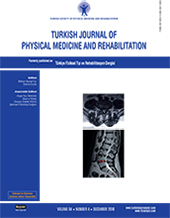Correlation between the Q angle and the isokinetic knee strength and muscle activity
2 Department of Sport Management, Faculty of Sport Sciences, Ondokuz Mayıs University, Samsun, Turkey DOI : 10.5606/tftrd.2018.2366 Objectives: The aim of this study was to investigate the correlation between the Q angle and the isokinetic knee strength and muscle activity.
Patients and methods: Between March 2016 and April 2016, a total of 50 healthy and right-leg dominant men (mean age 22.3±2.3 years; range, 18 to 27 years) with a Q angle between 5° and 20° and active in sports were included. An isokinetic strength test of the knee joint extensor and flexor muscles at angular velocities of 60, 120, 180, 240, and 300°·s-1 was tested who had a Q angle of 5 to 20° and were active in sports. Surface electromyography (sEMG) was used to determine these muscles` activity levels.
Results: Negative correlations were between the Q angle and the average peak torque (APT) in extension (E) and flexion (F), the average power (APE,F) at all angles, the joint angle at the PT (JAPTE) at 240, 180, 120 and 60°·s-1; JAPTF at 300, 240 and 180°·s-1; and the time to PT (TPTF) at 180°·s-1. There was a positive correlation between the Q angle and TPTE (at 60°·s-1). No significant relationship between the Q angle and the level of EMG activity at any angular velocity of the muscles, as well as the VM:VL EMG activity ratio was found.
Conclusion: A higher Q angle is associated with decreased isokinetic knee strength, power output, and torque angles. It is thought that possible high Q angle-related knee joint disorders and sports injuries can be avoided by including proper quadriceps strength exercises in exercise prescriptions to be prepared.
Keywords : Electromyography; isokinetics; muscle strength; patellofemoral joint; quadriceps angle; torque

















